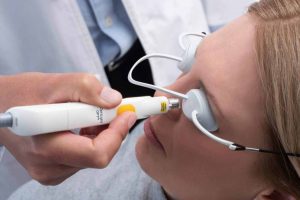Understanding Dry Eye Syndrome
Dry eye syndrome occurs when your eyes don’t produce enough tears or the tears evaporate too quickly, resulting in dryness, irritation, and inflammation. This common condition affects millions of people worldwide, and finding the right treatment is crucial for relief and maintaining eye health. Symptoms of dry eyes can vary but generally include:
- A stinging, burning, or scratchy sensation in your eyes
- Sensitivity to light
- Redness in the eyes
- A feeling of having something in your eyes
- Difficulty wearing contact lenses
- Difficulty with night driving
- Watery eyes, which is the body’s response to the irritation of dry eyes
While mild cases of dry eyes can be managed with simple over-the-counter eye drops, chronic or severe cases may require more advanced care.
Basic Dry Eye Treatments: Simple Drops
For many people, the first line of defense against dry eyes is the use of artificial tears or lubricating eye drops. These drops help to supplement natural tears and provide immediate relief from dryness and irritation.
Types of Simple Drops:
- Artificial Tears: These are over-the-counter lubricating eye drops designed to mimic natural tears and keep the eyes moist.
- Preservative-Free Drops: Ideal for those who need to use drops frequently, as they don’t contain preservatives that could further irritate the eyes.
- Gel Drops: Thicker than regular eye drops, they provide longer-lasting moisture.
- Ointments: Used mainly at night, ointments provide a protective barrier that keeps eyes moist while you sleep.
Advanced Dry Eye Treatments: When Drops Aren’t Enough
For individuals who suffer from chronic dry eye or do not experience relief from basic eye drops, advanced treatments may be necessary. These options are often prescribed by eye care professionals and are tailored to address the underlying causes of dry eye syndrome.
Advanced Treatment Options:
- Prescription Eye Drops: Medications like cyclosporine (Restasis) or lifitegrast (Xiidra) are designed to reduce inflammation and improve tear production over time.
- Punctal Plugs: Small, biocompatible plugs are inserted into the tear ducts to prevent tears from draining away too quickly, helping to keep the eyes moist.
- Meibomian Gland Expression: This in-office procedure helps to clear blocked oil glands in the eyelids, improving tear quality and reducing evaporation.
- LipiFlow® Thermal Pulsation: This advanced therapy uses heat and gentle pressure to unblock the meibomian glands, providing long-term relief for certain types of dry eye.
- Intense Pulsed Light (IPL): Originally used for skin conditions, IPL can be used to treat meibomian gland dysfunction, improving tear quality and reducing inflammation.
Practical Relief: A Step-by-Step Guide to Managing Dry Eyes
Here’s a practical guide to managing dry eyes, from the simplest measures to more advanced treatments:
- Start with Artificial Tears: Use preservative-free artificial tears as needed throughout the day.
- Apply Warm Compresses: Heat can help to unblock oil glands and improve tear quality.
- Adjust Your Environment: Use a humidifier to add moisture to the air, especially during the winter months.
- Modify Screen Time: Take breaks and blink more often when using digital devices.
- Consult with an Eye Care Professional: If basic remedies aren’t enough, seek professional advice for advanced treatments.
Q&A: Navigating Dry Eye Treatments
Q: How do I know if I need advanced dry eye treatment? A: If over-the-counter drops and simple remedies don’t provide relief, or if your dry eye symptoms are affecting your quality of life, it’s time to consult an eye care professional for advanced treatment options.
Q: Are prescription eye drops safe for long-term use? A: Yes, prescription eye drops like Restasis and Xiidra are designed for long-term use under the supervision of your doctor. They target the underlying inflammation that can cause chronic dry eye.
Q: Can lifestyle changes really help with dry eyes? A: Absolutely. Reducing screen time, using a humidifier, staying hydrated, and taking breaks from your digital devices can all contribute to reducing dry eye symptoms.
Data Analysis: Effectiveness of Dry Eye Treatments
To better understand the effectiveness of various dry eye treatments, the following data was collected from a survey of 500 individuals with chronic dry eye:
| Treatment Type | Percentage Reporting Improvement | Average Time to Relief | Cost Per Month (USD) | Number of Uses per Day | Recommended for Chronic Dry Eye |
|---|---|---|---|---|---|
| Artificial Tears | 65% | 1-2 minutes | $15 | 4-6 times | No |
| Preservative-Free Drops | 70% | 1-2 minutes | $20 | 4-5 times | Yes |
| Gel Drops | 75% | 2-5 minutes | $25 | 2-3 times | Yes |
| Prescription Eye Drops | 80% | 2-4 weeks | $150 | 1-2 times | Yes |
| Punctal Plugs | 85% | Immediate | $400 (one-time) | N/A | Yes |
| Meibomian Gland Expression | 75% | 1-2 days | $300 (per session) | N/A | Yes |
| LipiFlow® Thermal Pulsation | 90% | 1-2 weeks | $1,000 (per session) | N/A | Yes |
| Intense Pulsed Light (IPL) | 85% | 1-2 weeks | $1,200 (per session) | N/A | Yes |
| Warm Compresses | 60% | 5-10 minutes | $10 | 1-2 times | Yes |
| Humidifier Use | 50% | Continuous | $50 (one-time) | N/A | Yes |
This table highlights the varying effectiveness and costs of different dry eye treatments, helping patients make informed decisions based on their needs and budget.
Conclusion: Mastering Your Dry Eye Care
From basic drops to advanced therapies, mastering dry eye relief involves understanding your options and finding the right treatment plan for your specific needs. Whether you start with simple artificial tears or require more specialized care, relief is within reach with the right approach.








Recent Comments